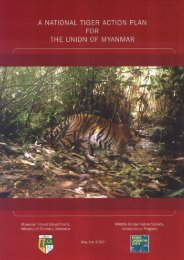Download - Global Tiger Initiative
Download - Global Tiger Initiative
Download - Global Tiger Initiative
You also want an ePaper? Increase the reach of your titles
YUMPU automatically turns print PDFs into web optimized ePapers that Google loves.
Protecting and/or recovering the natural prey base of Snow<br />
Leopards<br />
•<br />
•<br />
•<br />
•<br />
Grazing management and animal husbandry<br />
Governments, resource managers, conservation NGOs and development agencies<br />
should undertake efforts that will help to promote livestock grazing practices that<br />
reduce impacts on native wildlife. Community-generated grazing management plans<br />
should be developed after a careful analysis of land tenure systems, grazing patterns and<br />
wildlife needs (range, key lambing/kidding sites, winter pastures, etc.). The grazing plans<br />
should contain monitoring protocols and indicators of success and regular progress reports<br />
should be disseminated among participating stakeholders. In addition, information,<br />
training and technical assistance for animal husbandry should be provided to local<br />
communities to increase the economic value of the stock, thereby creating the possibility<br />
to reduce the number of animals grazing. Focus should be applied to areas where overgrazing<br />
by domestic livestock has led to declines in wild ungulates and where Snow<br />
Leopard predation is reported to be high. One option of value would be to prioritize<br />
allocation of pasture, so that in some areas wildlife is given precedence over domestic<br />
stock, for example at wildlife-viewing sites in protected areas.<br />
Unregulated/illegal hunting of prey species<br />
Governments, NGOs, scientific and other relevant institutions should compile<br />
information on the levels and impact of illegal hunting and/or unregulated hunting<br />
of wild ungulates and other Snow Leopard prey species in Snow Leopard range States<br />
and the motives that lead to the poaching of wild ungulates and other mammal species (i.e.<br />
subsistence, trade of certain body parts, minimizing competition with domestic livestock,<br />
etc.).<br />
“Pest control” programmes and the use of <strong>Tiger</strong> bone substitutes<br />
Governments, scientific institutions and NGOs should encourage, initiate and<br />
support research studies on the impacts of so-called “pest” control programmes for<br />
smaller mammals that are important Snow Leopard prey species, such as pikas, and molerats,<br />
the bones of which are also promoted as an official substitute for <strong>Tiger</strong> bones.<br />
Prey species conservation and managment<br />
Governments, scientific institutions and NGOs should encourage and support studies<br />
that focus on the biology, population trends and habitat needs of wild ungulates, in<br />
particular those that are known to be important Snow Leopard prey species, to improve the<br />
understanding of the most important threats posed to these species and investigate the<br />
specific effects that livestock and human activities have. The findings of these studies<br />
should be used to promote effective management of protected areas in key habitats, i.e.<br />
those that support important populations of wild ungulates. Assistance should be provided<br />
to range States to implement existing management plans for protected areas and to create<br />
new plans for protected areas, where necessary.<br />
FADING FOOTPRINTS: the killing and trade of Snow Leopards 59

















